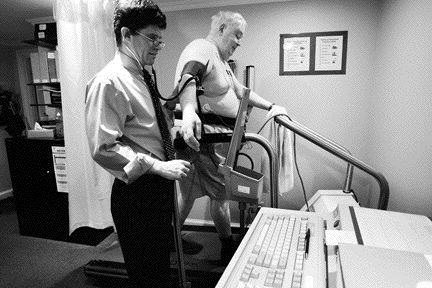
How much can your ticker take? Test will tell
Reality check. If you're new at exercise game
JILL BARKER, The Gazette
Published: Tuesday, February 27, 2007
The more you move, the less likely you are to get heart disease. That's a given. But what about those who after years of avoiding exercise are keen to erase the side effects of inactivity? Can they pull themselves out of the Barcalounger and head directly to the gym or will a good old-fashioned workout be more than their out-of-shape ticker can take?
According to health and fitness experts, when it comes to heart disease, your 40th birthday is the day of reckoning, meaning anyone who is old enough to remember a world without Britney, TomKat and Brangelina may need more then good intentions before starting an exercise program. What's needed, say the experts, is an exercise stress test.

Dr. Steven Grover puts Jean Laliberte through a stress test at the CHIP office.
Photograph by : MARCOS TOWNSEND, THE GAZETTE
What is an Exercise Stress Test?
It consists of a series of three-minute stages on a treadmill or stationary bike. The speed and incline (tension in the case of a bike) are gradually increased until one of several things occurs: the exerciser reaches exhaustion, ends the test voluntarily, shows signs of heart stress or reaches 90 per cent of his/her maximum heart rate.
During the test, a trained person, who also keeps an eye out for any sign of visible distress, electronically monitors the exerciser's heart. Once the test is complete, the results regarding how well your heart responds to vigorous exercise is reviewed.
Who Needs One?
The American College of Sports Medicine recommends men over 40 and women over 50 as well as anyone younger with more than one coronary risk factor (smoking, inactivity, high blood pressure, high cholesterol, obesity, Type 2 diabetes, or a family history of heart disease) have an exercise stress test before starting a vigorous exercise program.
Steven Grover, physician and director of the McGill Cardiovascular Health Improvement Program agrees. The test's purpose is to detect heart disease before some unsuspecting exercise novice pushes his or her heart beyond what it can handle. The combination of intense physical activity (which the American College of Sports Medicine defines at 60 per cent or above maximum aerobic capacity - about the same intensity as a brisk walk) and undiscovered heart disease can be deadly.
Who Doesn't?
Before you run to the doctor in search of a prescription for an exercise stress test, stop: not every baby boomer needs one. Healthy individuals within the targeted age group who are already exercising generally don't need to be tested. If that describes you, don't stop reading, there are exceptions.
If you are a regular exerciser and suddenly find yourself uncharacteristically short of breath, experiencing chest pain during a workout or have a family history of heart disease, a visit to a physician is a must and a stress test will probably be prescribed.
Keep in mind 35 per cent of men over 40 have some form of metabolic syndrome (high blood pressure, abdominal obesity, insulin resistance) that increases their risk of coronary heart disease. That includes exercisers and non-exercisers alike, especially those with a waistline that measures more than 100 centimetres around in men, and more than 88 centimetres in women.
What the Results Tell You
If your heart shows an unhealthy response to exercise, you'll probably be referred for more conclusive tests. For those with a healthy heart, but who bail out of the test early out of exhaustion, the results will help the technician prescribe an exercise intensity that is challenging enough to improve heart health but not so challenging that your heart is taxed beyond its capabilities.
What the Results Don't Tell You
Despite the call among health and fitness professionals for a certain subset of the population to take a stress test, Grover says the results can be misleading.
"We miss (spotting heart disease) in about 30 per cent (of those tested)," he said. "And about 20-30 per cent are false-positives."
Part of the reason a favourable result isn't always cause for relief is that an exercise stress test can detect only a 70 per cent or greater obstruction of the coronary artery. So, if you have only 50-60 per cent of normal blood flow, an exercise stress test won't pick it up.
Also interesting to note is the test seems to be less reliable among women, who record the most number of false positives.
Finally, this test shouldn't be confused with a VO2 max test, which measures aerobic capacity. A far more intense test, V02 max tests measure the strength of the cardio respiratory system among the fit and healthy - not middle-aged exercise novices.
The Bottom Line - Should You or Shouldn't You?
If you fall into the high-risk category as defined by the ACSM, talk to your doctor about the benefits of taking an exercise stress test. According to a 1997 study, co-written by Steven Grover and published in the Journal of Cardiopulmonary Rehabilitation, of the 4,074 men (mean age 45.3 years) and women (mean age 46.5 years) with no known heart disease who took an exercise stress test, 5.4 per cent had abnormal results.
Getting the okay before heading into the gym isn't such a bad idea for former couch potatoes looking to change their spots. And the best thing about this test, is that even if you fail, you win. An early warning about heart disease is better than no warning at all.
[email protected]
© The Gazette (Montreal) 2007 |



